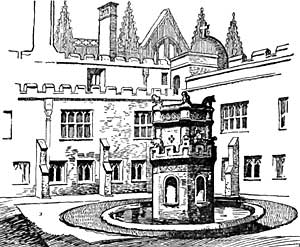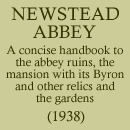
The Fountain and Cloister Garth.
The eastern walk of the cloister has special points of interest. It was through the small door leading from here into the south transept that the monks entitled to sit in the Choir would enter the church. In this part of the Cloisters is a stone seat said to have been used for the traditional ceremony of the Washing of the Feet on Maundy Thursday. It may be noted in passing that the pavement of the Cloisters originally ran at a higher level than the present one; this is indicated by the mouldings of the walls.
From the Cloisters we enter the Chapter House of the monastery, now furnished as a chapel. The Chapter House was not, however, consecrated for worship in monastic times. It was the place in which all the business of the monastery was transacted; confessions were heard here, and here also the Prior would pronounce disciplinary sentences upon monks who had transgressed the strict Rule of the Order. The beautiful slender Early English columns supporting the roof, with their delicately carved capitals, deserve special notice. The painted decoration of the Walls, with the exception of the armorial coat, is said to have been based upon the designs of surviving patches of the original decoration found here before the apartment was restored. The "family pew" to the left, at a higher level than the general floor, so that its occupants could follow the services in the chapel without being exposed to the view of servants and others forming the "general congregation," is a comparatively recent addition formed by opening the original wall on that side and taking in part of an adjoining room.
 Detail of capital in Chapter House.
Detail of capital in Chapter House. As to the general place of the Cloister in the life of a monastery, it may be said briefly that the monks spent a large portion of their lives here; it was the place for work and study and was usually fitted with "Carrells"—small spaces screened off from each other—so that each monk could concentrate upon his own task and not be exposed to the temptation to lethis attention wander towhat others were doing. In the wall of the south walk of the Cloister will be seen parts of the columns of the staircase which usually, at this south-east angle, led up to the dormitories which ran above the Cloister. An interesting modern detail of the Cloister is a stone tablet affixed to the wall, close to the Chapter House door, setting forth the names and dates of the Priors of Newstead in complete sequence from the founding of the Priory until the Dissolution. Yet another detail to be noticed is the broad archway in the wall above what was once the washing-place of the monks.
Our circuit is now almost completed. On leaving the Cloister at the point at which we entered—and where, by the way, a heavy ancient door of oak still swings on its hinges—we enter the restored Monks' Parlour, a small vaulted apartment which forms a kind of ante-room to the larger Crypt which is entered by descending two or three steps. We have already had a passing glimpse of this undercroft when we entered the Abbey buildings. Some of the stonework of the pillars supporting the vaulting has had to be renewed in recent times and the conjunction of old and new work can be recognized on close inspection; but in its general aspect the Crypt is virtually unchanged from what it must have looked like in the days of the monks. It was a place of importance in the domestic life of the monastery, for it was here that the Cellarer kept his stores and here also, the "broken victuals" may have been distributed to the poor. At the farther end of the Crypt is the door by which we entered the Abbey; thus our tour of the interior runs to its completion and we are ready to see what the gardens have to offer us.*
*In the Crypt have now (1938) been assembled three monuments removed by a special faculty from the ruined church at Colwick. They are the monuments of the first Sir John Byron to whom Newstead was granted in 1540, and who died in 1576; of his son, "Little Sir John with the great Beard" (died 1609); and of the third Sir John, who died in 1625.
